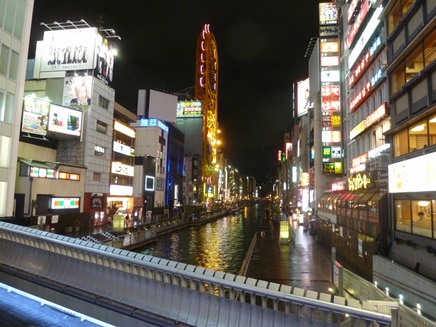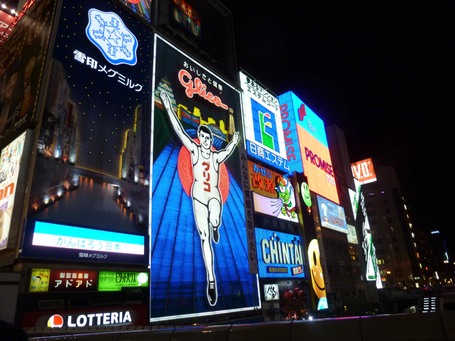
We went back and forth a couple of times over the course of the afternoon and evening, which was largely spent in the Ebisubashi-suji shopping district, which opens off the street that takes its name from the Dōtonbori canal, which means it's time for another excursion into the realms of history.
While it's the main destination for food travel in Osaka, Dōtonbori owes its origins to a decision back in 1612, when a local entrepreneur, Dōton Yasui, decided to connect the two branches of the Yohori River, which run north to south, with a canal. He set out to do this by expanding the Umezu River, which ran east to west, and the intention was to increase commerce in the region. Along the way, Dōton became involved in the Siege of Osaka and died defending Toyotomi Hideyori, but his cousins finished the project in 1615 and the new ruler in Osaka Castle, Tadaki Matsudaira, named the canal and avenue beside it Dōtonbori (Dōton's canal) even though he'd been on the wrong side of the result in the siege.

Six years later the Tokugawa Shogunate designated Dōtonbori as Osaka's entertainment district and by 1662 the street had six Kabuki (classical Japanese dance-drama) and five Bunraku (traditional puppet)theatres, and the Takeda Karakuri mechanical puppet theatre. The theatres were so popular they encouraged numerous restaurants and cafes to open, catering to the flood of tourists and entertainment-seekers who poured into Dōtonbori, and while there has been a decline in support for traditional forms of entertainment and Dōtonbori's five remaining theatres were bombed and destroyed during World War II it remains a prime attraction for culinary tourists.
Today Dōtonbori is famous for its shops and restaurants, and the neon and mechanised signs that line the canal and feature in the shopping areas. For a start there's snack/candy manufacturer Glico's giant runner crossing the finish line, though he's just one part of a formidable barrage of electronic advertising. Inside Ebisubashi-suji there's s six and a half metre mechanised crab that moves its arms and eyestalks in front of a crab restaurant called Kani Doraku that dates back to 1960 and spawed a number of similar creations, including a squid that puffs steam.
We took a leisurely ramble through Dotonbori, along the arcade that leads to Namba station, where The Sister bade us farewell, and back through a major electronics store and Tower Records, eventually looping into the hotel to check in and looping back out to chase up a Wi Fi hotspot and dinner.
More...